Fix: Failed to create Directx device
The error “Failed to create Directx device” is typically encountered by users when opening a built-in Windows game (Minesweeper, Solitaire, etc.) or when opening Windows Media center. This particular issue is only encountered on OS versions older than Windows 8.

After investigating the issue thoroughly, we came up with a shortlist of potential culprits that might be causing the issue:
- Windows updates were downloaded by WU and are pending to install – If this is the cause of the issue, rebooting your machine and allowing it to install the updates will automatically resolve the issue.
- A conflict between Windows Media Center and built-in OS game – As it turns out, the error might be displayed when two applications are actively using the same DLL file (Windows Media Center and one built-in Windows game).
- Beta graphics drivers are causing the issue – If this is the cause of the error, reverting to a stable driver will resolve the issue
- The issue is caused by Windows glitch – It can be resolved by reinitiated the built-in Windows games from Windows Features.
If you’re currently struggling with this particular issue, use the collection of methods below to troubleshoot the issue away. Please follow each method in order until you encounter a fix that manages to resolves the problem. Let’s begin.
Method 1: Reboot to install pending Windows updates
You should start your troubleshooting quest by making sure you have no pending Windows updates. As some users have pointed out, the issue can arise right after WU (Windows Update) finishes downloading an update. If that’s the case, a simple reboot will remove the error message indefinitely. If you have the habit of using the sleep function instead of shutting down your computer when you’re not using it, there’s a strong chance that you’ve just identified the culprit.
Depending on the pending update, it might only install partially after WU finishes downloading it – This can cause unexpected errors until the user reboots the system and allows it to install the update fully. Whether you think you have a pending update or not, reboot your system and see if the issue gets automatically resolved.
If a reboot hasn’t resolved your issue, continue with the method below.
Method 2: Resolving an application conflict
Depending on your OS version, you might find the Windows Media Center will automatically run at startup. While this is certainly not an inconvenience, it can cause problems with certain applications that are using the same DLL files.
As some users have reported, whenever Windows Media Center is opened or minimized, you might encounter the “Failed to create Directx device” error while trying to open a built-in game. Although the technical aspects of this issue are not clear, it seems like they are both configured to use some of the same DLL files.
If you get this error while opening a game, investigate if Windows Media Center is opened. In the event that it’s opened, close it properly (do not minimize it) and see whether it has resolved your issue. If it has, make sure you close Windows Media Center whenever you decide on playing a built-in game.
Note: Keep in mind that you can also apply this potential fix in reverse. E.g. you get the error while opening Windows Media Center, close any built-in game that might be currently running to resolve the application conflict.
If this method wasn’t effective, move down to Method 3. In the event that you want to use Windows Media Center while playing a built-in game, refer directly to Method 4.
Method 3: Install a stable graphics card driver (if applicable)
The “Failed to create Directx device” issue can also be caused by your graphics card drivers. If you own a newer GPU, you might be tempted to install the beta driver – as it usually promises performance optimizations for the latest games. However, this is not always beneficial, as beta drivers are often not WHQL (Windows Hardware Quality Labs) certified. Because of this, you might find that certain Windows functions (including built-in games) will not function properly and display the error as a result – while using beta drivers.
Note: You can skip this method if you’re certain that the graphics driver used by your system is WHQL certified.
If you’re currently using a beta graphics driver, follow the steps below to uninstall it and install a WHQL certified driver for your GPU:
- Press Windows key + R to open a Run window. Type “appwiz.cpl” and hit Enter to open Add or Remove Programs.
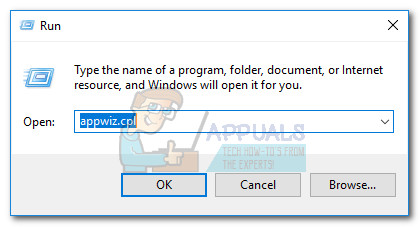
- In the Add or Remove Programs window, scroll down to your GPU drivers and Uninstall the graphics driver.
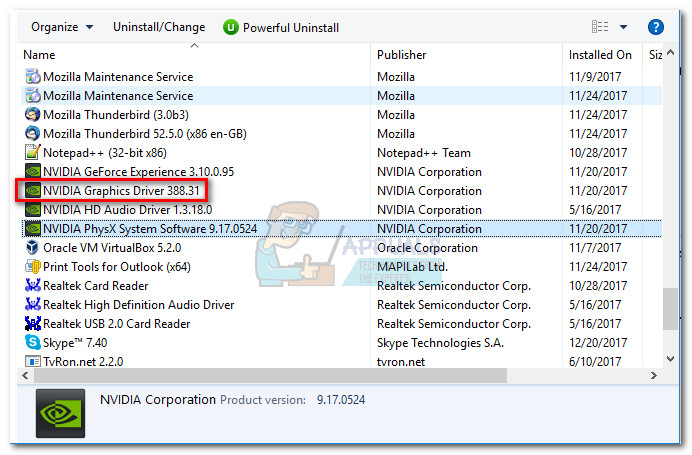
- Once the driver is removed, navigate to your GPU manufacturer’s website and download the latest stable build. Use this link (here) for Nvidia and this link (here) for ATI.
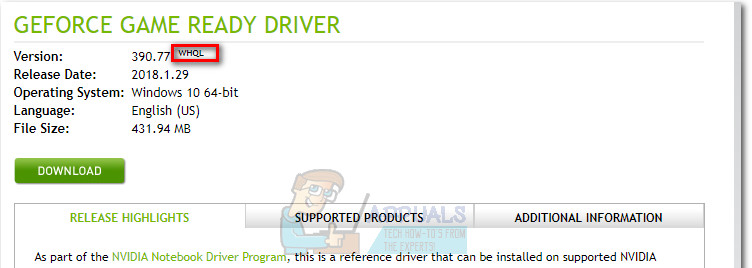 Note: If you use the default downloading channels, you probably won’t end up with a beta driver. However, double-check that you install a stable build by looking for a WHQL icon near the driver’s name or in the description.
Note: If you use the default downloading channels, you probably won’t end up with a beta driver. However, double-check that you install a stable build by looking for a WHQL icon near the driver’s name or in the description. - Install the graphics driver and reboot your system to finish the installation. Check if the issue is now resolved by opening one of the built-in games.
If you’re still bothered by the same issue, move to the method below.
Method 4: Moving games files to a new directory
If you’ve followed all of the above methods without a result, there’s one user-created fix that might resolve your issue. It involves moving game files to a newly created folder outside the predetermined paths. This will eliminate any DLL conflicts that might trigger the “Failed to create Directx device” error.
Follow the steps below move the built-in games files to a separate directory:
- Create a new folder outside the protected paths and name it whatever you want (we named it Games). The folder’s location doesn’t matter, as long as it’s different from the default path of the built-in games.
- Navigate to C:/ Program Files / Microsoft Games, and copy all the game folders that are present there.
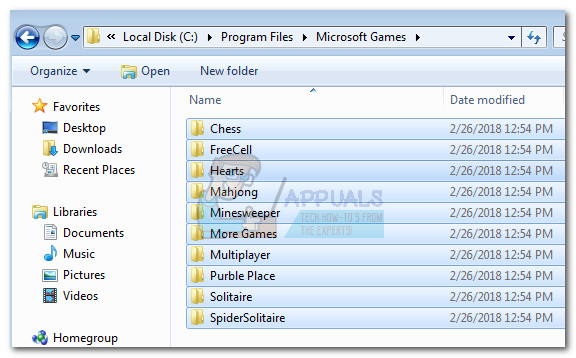 Note: Be careful not to confuse the paths. The Microsoft Games folder is located in Program Files (not Program Files (x86)).
Note: Be careful not to confuse the paths. The Microsoft Games folder is located in Program Files (not Program Files (x86)). - Paste the folders copied from the Microsoft Games folder into the newly created Games folder.
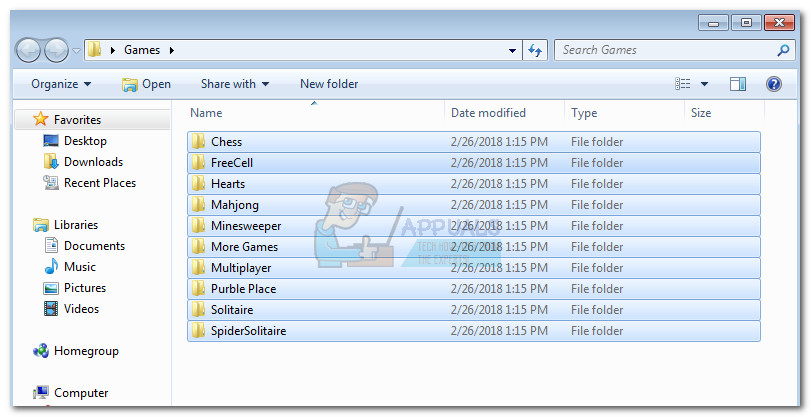 Note: If you only play a few of the games listed here, you can only copy the folders of those games that you actually play.
Note: If you only play a few of the games listed here, you can only copy the folders of those games that you actually play. - Once the built-in game folders have been copied, you can open them without issues by double-clicking the executable.
Note: You can make things even easier for you by creating a desktop shortcut of the game executable. To do this, right-click on the game executable and select Send to > Desktop (create shortcut).
If you’re still presented with the same “Failed to create Directx device” error, move down to the final method.
Method 5: Re-enabling Games from Windows features
If all of the above methods have proved to be ineffective, let’s take the steps appropriate to resolve a known Windows glitch that can be causing the problem. Some users have pointed out that turning off game features, rebooting, then turning them back on has automatically resolved the issue. This will force Windows to reinitiate the components needed to run the game, thus solving the problem.
Follow the steps below to re-enable the built-in games from Windows Features:
- Press Windows key + R to open a Run window. Type “appwiz.cpl” and hit Enter to open Add or Remove Programs.

- In Programs and Features, click on Turn Windows features on or off.

- Now look for a folder named Games and deactivate the checkbox next to it. This should automatically disable all the built-in games. Hit Ok to confirm.

- Wait until Windows makes the necessary changes, then reboot your computer.
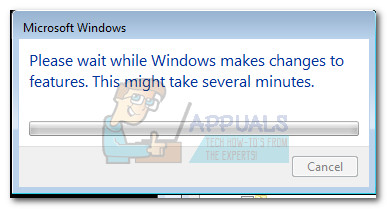
- Once your computer boots back up, use steps 1 and 2 again to return to Windows Features. Once there, re-enable the checkbox next to Games and hit Ok to confirm.

- Windows will take a while to re-enable the gaming components. If not prompted to restart, do so on your own and see if the issue has been resolved at the next startup.